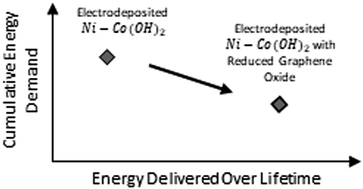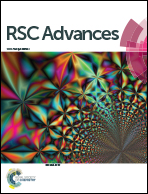Life cycle assessment of emerging Ni–Co hydroxide charge storage electrodes: impact of graphene oxide and synthesis route†
Abstract
Decoupling energy supply from fossil fuels through electrification and sustainable energy management requires efficient and environmentally low-impact energy storage technologies. Potential candidates are charge storage electrodes that combine nickel and cobalt hydroxides with reduced graphene oxide (rGO) designed to achieve high-energy, high-power density and long cycling lifetimes. An early eco-efficiency analysis of these electrodes seeks to examine the impacts of materials and processes used in the synthesis, specifically while focusing on the use of rGO. The emerging electrodes synthesized by means of electrodeposition, are further compared with electrodes obtained by an alternative synthesis route involving co-precipitation. Life cycle assessment (LCA) method was applied to compare a baseline nickel–cobalt hydroxide electrode (NCED), the focal electrode integrating rGO (NCED-rGO), and the benchmark co-precipitated electrode (NCCP), for delivering the charge of 1000 mA h. Contribution analysis reveals that the main environmental hotspots in the synthesis of the NCED-rGO are the use of electricity for potentiostat, ethanol for cleaning, and rGO. Results of comparison show significantly better performance of NCED-rGO in comparison to NCED across all impact categories, suggesting that improved functionalities by addition of rGO outweigh added impacts of the use of material itself. NCED-rGO is more impactful than NCCP except for the indicators of cumulative energy demand, climate change, and fossil depletion. To produce a functional equivalent for the three electrodes, total cumulative energy use was estimated to be 78 W h for NCED, 25 W h for NCED-rGO, and 35 W h for NCCP. Sensitivity analysis explores the significance of rGO efficiency uptake on the relative comparison with NCCP, and potential impact of rGO on the category of freshwater ecotoxicity given absence of removal from the process effluent. Scenario analysis further shows relative performance of the electrodes at the range of alternative functional parameters of current density and lifetime. Lastly, the environmental performance of NCED-rGO electrodes is discussed in regard to technology readiness level and opportunities for design improvements.



 Please wait while we load your content...
Please wait while we load your content...